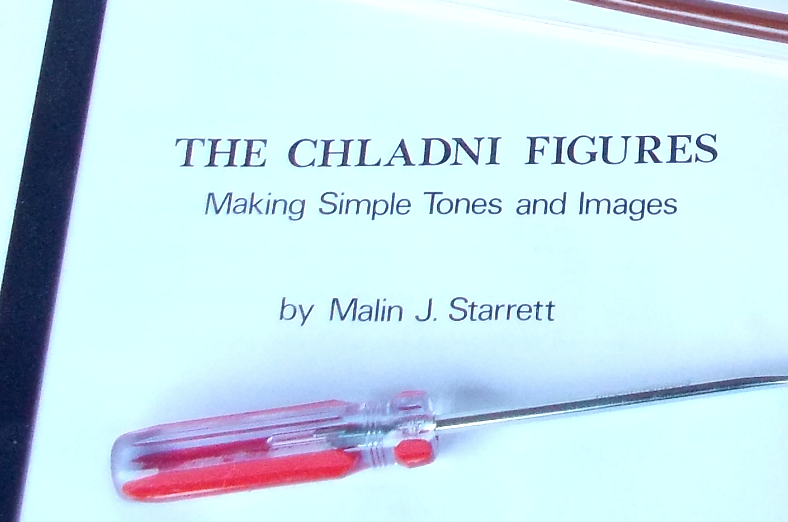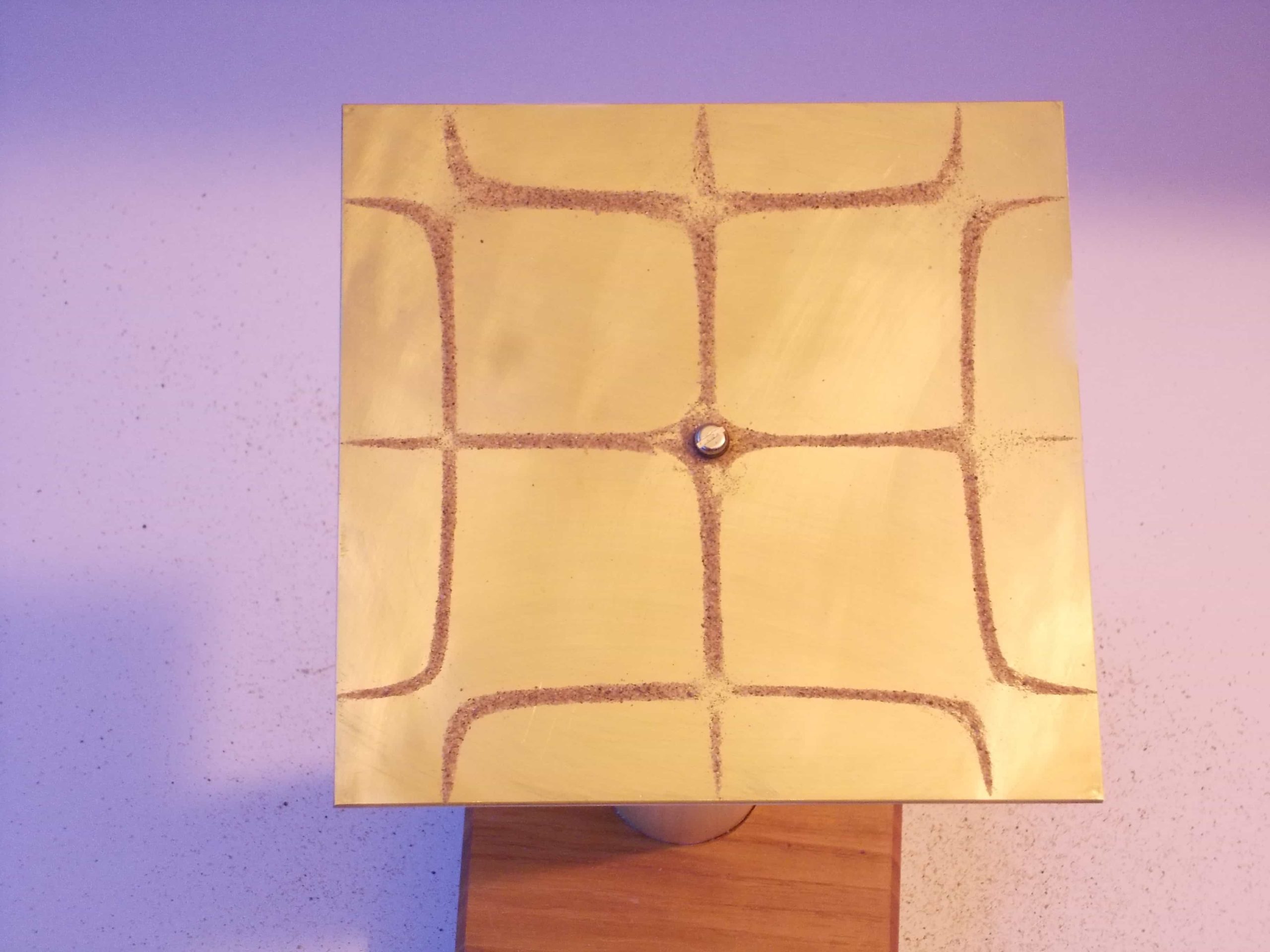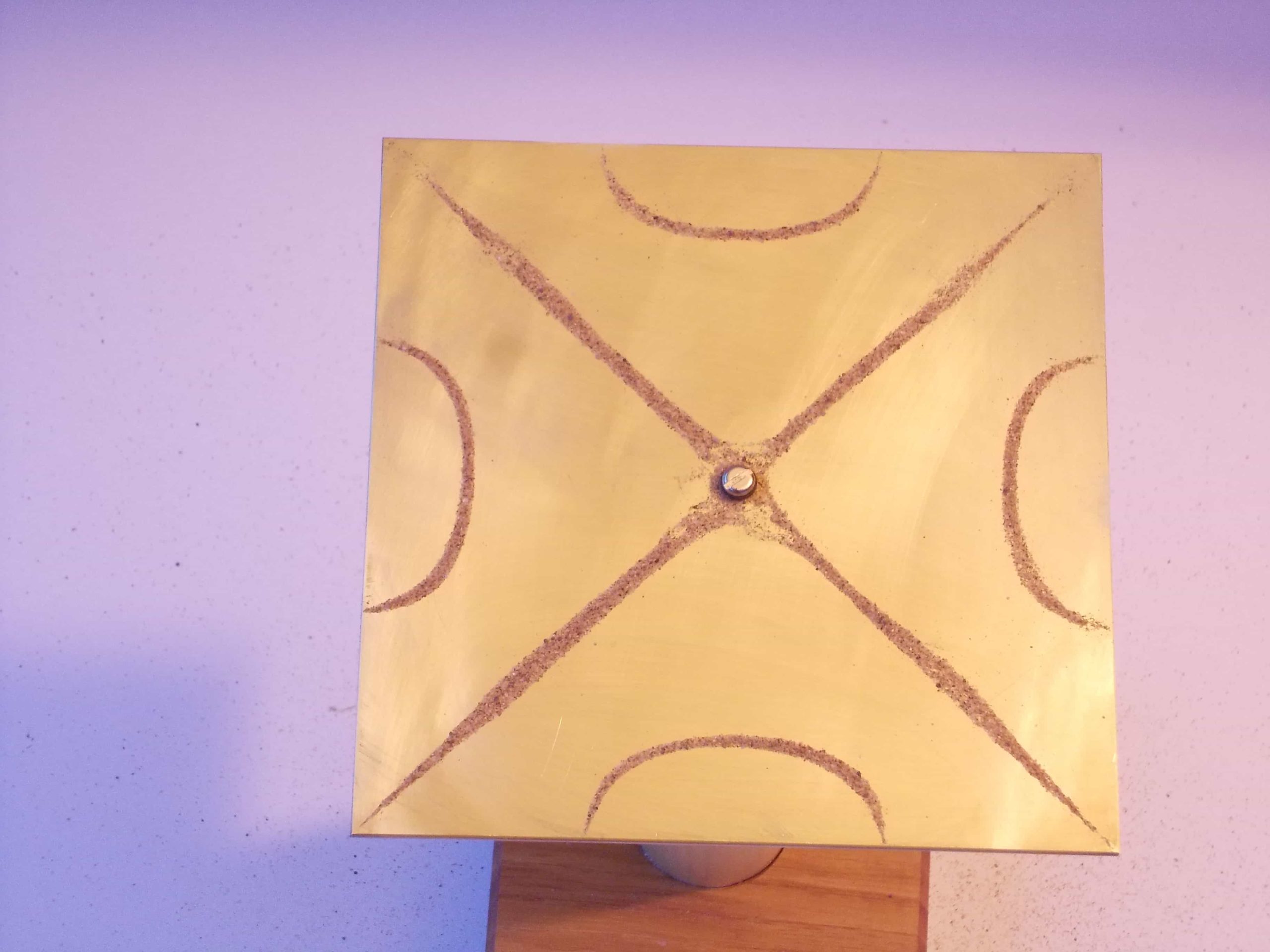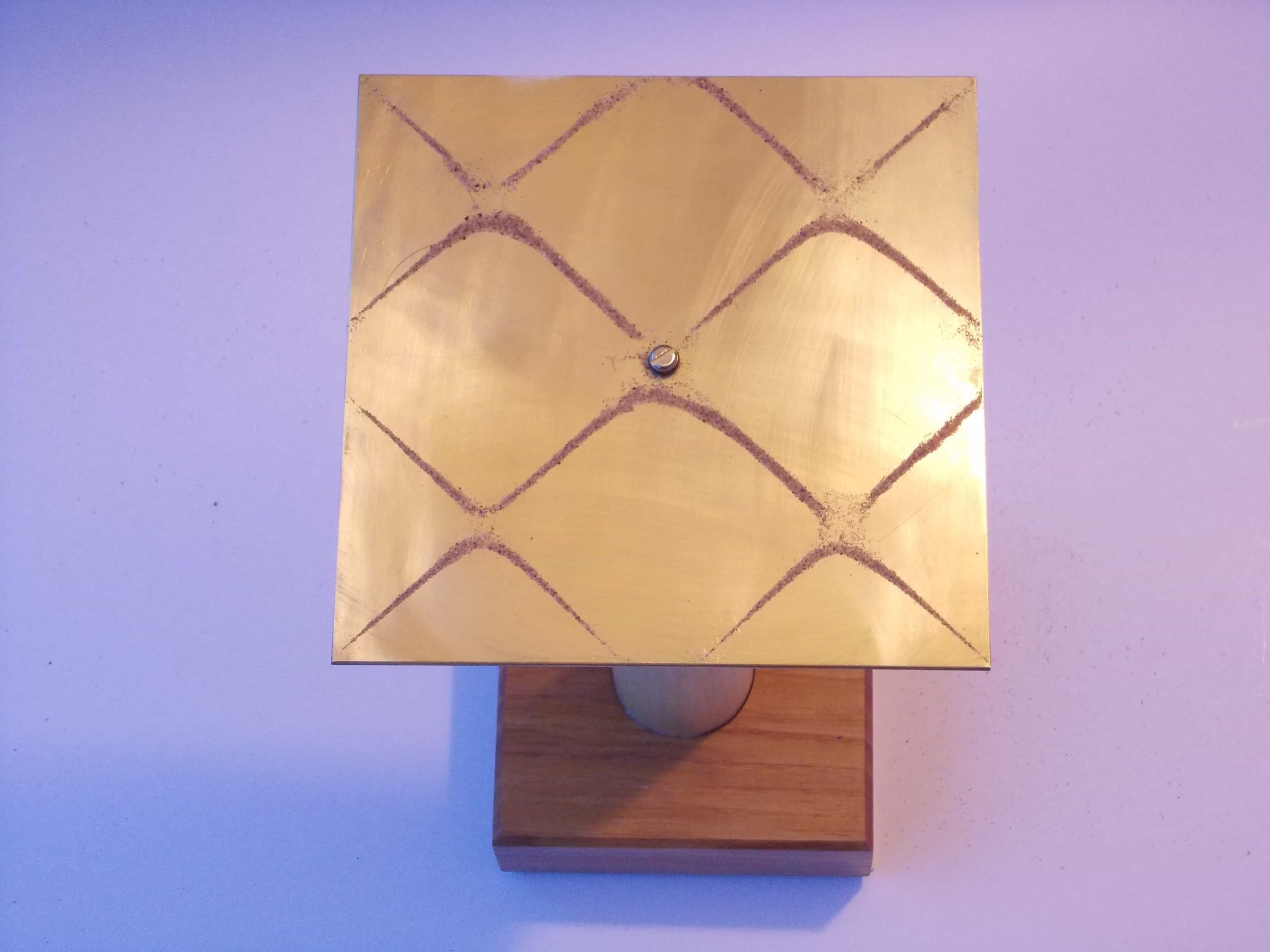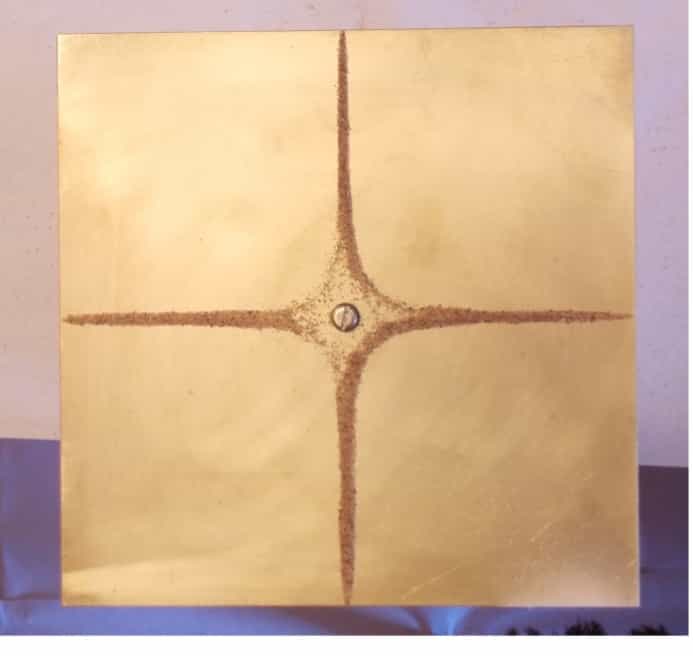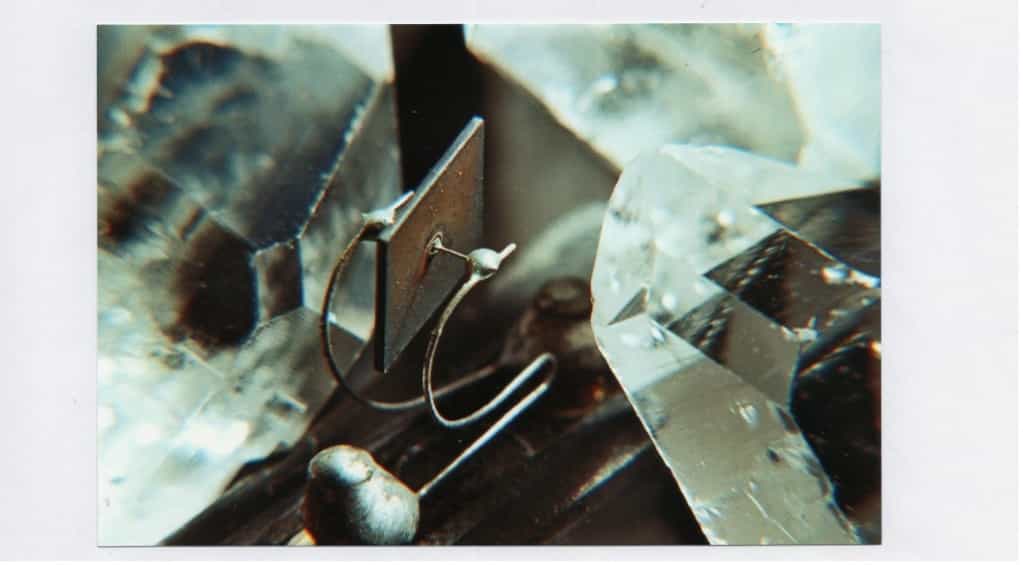-Experience Of Experimenting-
Chladni Plate KitChladni plate Kit
This kit contains everything in one box to enable you to produce the Chladni Figures. You can perform these experiments as a regular artistic exercise – producing pure tones and simple geometric images. This is the ‘slow food’ of sound and vision! Each square Chladni plate is individually crafted, tuned and tested to be within about 1 Hertz of a specific fundamental tone – all the other tones and patterns build up from this fundamental.
£150- Plus Postage
How To Order
The Kits are hand made in Ireland by Malin Starrett. Please use the email or phone number below to place an order.
00447907518462 (if there is no reply send a text message and he will get back to you)
The kit can also serve a centre piece to explore the science of sound.
Illustrated Manual
Chladni Plate Patterns: Example One
The fingers are placed upon the brass plate to produce different patterns when played using the bow.
Chladni Plate Patterns: Example One
The fingers are placed upon the brass plate to produce different patterns when played.
Chladni Plate Patterns: Example Two
Chladni Plate Patterns: Example Three
With only a little practice beautiful patterns can be produced revealing some of the mysteries of sound and matter.
Chladni Plate Patterns: Example Three
Whats In The Box
In short, the kit is unique in offering well formed patterns with pure musical tones (most of the other systems commercially available today produce awful noises, not musical tones). Contents of the kit: hand—made square brass Chladni plate; hand—made wooden base with special fixing; small violin bow; rosin; sand; lycopodium; nylon G-clamp; screwdriver; plastic bottle and pipe and a 38 page illustrated manual.
Please note: The kit is designed for adults and young people 16 years and over. However, many of the experiments are suitable for children with adult supervision.
Some Historical Notes of the Chladni Figures
Pythagoras’ discovery relating to musical intervals and the vibrations of strings is sometimes stated to be the beginning of mathematically oriented physics. It took another 2300 years after Pythagoras’ discovery until someone began to reveal the secrets of vibrating surfaces – two dimensional systems. In 1785, E.F.F. Chladni discovered that if he sprinkled a little sand on a circular plate of glass and then bowed it on the edge, various patterns would appear in the sand, along with various tones.(1) Chladni’s discovery and his subsequent researches are often stated to be the foundations of modern acoustics – the science of sound.
Chladni’s early researches were described in his book Entdeckungen über die Theorie des Klanges (Discoveries in the Theory of Sound), from 1787.(2) His experiments roused great public interest and he toured Europe giving lectures and demonstrations. Napolean was so impressed with the German man’s experiments that he financed the translation of Chladni’s 1802 book Die Akustik into French – Traité d’Acoustique.(3) The French Institut also put up a prize in 1809 for anyone who could explain from theory the various tones produced by vibrating Chladni plates. The prize was eventually awarded in 1815 to Sophie Germain who had to use a male pseudonym to have her work considered!(4) Interestingly, women have played central roles in acoustic and musical scientific researches, even when all societal expectations – and restrictions – made progress difficult for them.
The first few decades of the 19th century was a time when some of Europe’s greatest experimental scientists carried out remarkable researches on the Chladni Figures and more generally in the science of vibrations. The French man Felix Savart carried out some amazing researches in acoustics which included discovering rotating Chladni Figures and also water jets becoming sensitive to sound.(5) In England, Michael Faraday produced a masterful paper in 1831 exploring the subject of Chladni Figures (Acoustical Figures) produced in very fine and light powders such as lycopodium. This paper, “On a Peculiar Class of Acoustical Figures…”(6) is sometimes stated to represent Faraday at the peak of his scientific powers. Also in England, Faraday’s friend Charles Wheatstone was able to produce a ‘picture theory’ to explain all the various patterns produced on a square plate. It involves imagining two independent groups of plane standing waves meeting each other on/in the plate at various angles and with various phase relationships.(7) Acoustic theory based on superimposed pictures!
The later 19th century was an age of multiple world-changing inventions. The public – and investors – were open to just about any new discovery. Into this fertile environment appeared the U.S. inventor J.W. Keely, who was building and exhibiting marvellous high precision musical-mechanical machines. Keely claimed his technology utilised an entirely new force unknown to physics and that he could power a big ocean liner across the Atlantic ocean using only a cup full of water and musical vibrations!(8) Keely stated that Chladni’s work was his favourite. If you do believe that Keely made an astounding new discovery, as yet unrecognised in mainstream physics (and many leading engineers and scientists of the day were convinced), this doesn’t necessarily entail that it would become a new world-changing technology. In fact, Mr. Edison’s phonograph appeared just around the same time as Keely’s early inventions, distracting attention from the ‘other’ new acoustic technology. After a shaky start, Edison’s recorded sound was soon joined by moving pictures and the new entertainment technologies rapidly expanded into the 20th century, with Keely’s work largely forgotten. Why bother training yourself inwardly to have a morally pure soul impulse to start a machine when you can simply press a button and have endless entertainment?(9) It is interesting to note that in German, a gramophone record is called a Schallplate – a ‘sound plate’ – vaguely referencing Chladni plates.(10)
Figure 1 The cross form pattern of the fundamental tone
If Sophie Germain promptly derived the tones of circular disk plates from theory (c.1810 – 1815), the tones of square plates defied theoretical treatment for a long time. (Wheatstone’s ‘picture theory’ discussed earlier only related to the patterns, not the tones.). It took J.W. Strutt, 3rd Lord Rayleigh, to find the theoretical derivation of the fundamental tone of the square plate in the 1870s. This involved an entirely new principle in physics, now known as the Rayleigh Principle.(11) Several decades later in 1909, the young Swiss physicist Walter Ritz completed the theoretical derivation of the higher tones/modes produced by the square Chladni plate.(12) Their combined theoretical innovation is known as the Rayleigh-Ritz Principle.
In the mid. 20th century, the field of experimental work with Chladni Figures was dominated by Mary Waller. Her book Chladni Figures – A Study in Symmetry (1961) is a wonderful document of many years of patient researches – you can see whole pages of photographs of dozens of different patterns produced on various shapes of plates – circular disks, squares, rectangles, ellipsoids, triangles, pentagons, hexagons, octagons etc. She also showed the transformations of patterns as the shape of a plate is changed in graduated steps. The patience and determination required to search experimentally for all those modes of vibration on different shapes of plates should not be underestimated. She obviously knew all about theory but kept experimental work to the centre.(13)
Later, in the 1960s, Hans Jenny’s Cymatics (1967) appeared as an impressive illustrated book which completely broke the link with previous studies.(14) This acoustic research was ‘dropping out’ from conventional science – along with the hippies! Jenny’s invention of a new name – Cymatics – indicates the extent of this break. On the one hand, it is understandable that a radically new approach might have been needed to make the wonder of acoustic patterns accessible to the wider public but on the other hand, such an approach has meant that his work sits in isolation, with many subsequent workers chasing after ‘nice patterns’, but with little understanding of the phenomena, or the diligent researches of others in the past. Jenny’s technique of using electronic signal generators and electrical transducers to stimulate the vibration modes is also often used by experimenters today, but the acoustic sounds/noises generated are often harsh and unpleasant. Experimenters are usually searching for interesting visual patterns while ignoring the other half of the phenomenon – the tones. A good Chladni Figure should be well formed along with a pure acoustic tone. (The fundamental tone of the Chladni plate may also be important in determining the human experience of the rising sequence of tones of the various modes of vibration.)
Figure 2 Natural quartz crystals surrounding a quartz electrical device
In fact, ‘solid state’ electronics is anything but solid – the mechanical vibrations of crystalline materials are used in multiple ways in electronic technologies, particularly in communication technologies (e.g. in smartphones).(15) Today, the Chladni Figures have been mostly shackled to electrical and electronic phenomena, hidden inside tiny metal cans and plastic encapsulations, out of sight and out of human hearing range. Someday, they may again become seen and heard and appreciated by many more people. Who knows, maybe an amazing new musical-mechanical technology is waiting to be discovered, with the Chladni Figures as a central feature.(16)
Notes
1. Tyndall, J. Sound, Longmans, Green and Co.; 1883; Lecture IV.
2. A few pages from Chladni’s Entekungen über die Theorie des Klanges have been translated and are published in: Lindsay, R. Acoustics:Historical and Philosophical Development, 1972(?). Chladni’s Traité D’Acoustique has been recently translated and is published as Treatise on Acoustics, Springer, 2015.
3. See note 2. Some of Chladn’s scientific articles were translated into English by Tilloch and were published in the Philosophical Magazine. See the Royal Society Catalogue of Scientific Papers 1800 – 1863.
4. Waller, M. Chladni Figures – A Study in Symmetry, Executors of Mary D. Waller, 1961, xix.
5. Tyndall, J. Sound (see note 1). Lecture VI discusses Savart’s researches on water jets. However, Savart’s description of rotating cloud rings above circular disk Chladni plates does not appear to be discussed anywhere in the literature of acoustics in the English language – except for this essay and in a privately published experimenting manual written by the present author (c.2002).
6. Faraday, M. “On a Peculiar Class of Acoustical Figures; and on certain Forms assumed by groups of particles upon vibrating elastic Surfaces.”, also the appendix attached to the paper “On the Forms and States assumed by Fluids in contact with vibrating Elastic Surfaces.” Originally published in Philosophical Transactions of the Royal Society, Vol.121 (1831), p.299 – 358.
7. Wheatstone, C. “On the Figures obtained by strewing Sand on Vibrating Surfaces, commonly called Acoustic Figures.”, Philosophical Transactions of the Royal Society, Vol. 123 (1833), p.593 – 633.
8. Keely’s work features large in the literature of alternative science. A balanced and very wide-ranging study of Keely’s work is the book by Paijmans, T. Free Energy Pioneer: John Worrell Keely, Illuminet Press, 1998.
9. The present author can supply references on request for researches regarding the complex spiritual-technical-moral issues in this area.
10. Adorno, T.W. “The Form of the Phonograph Record” (1934) contained in the collection by Adorno: Essays on Music, University of California Press, 2002, p. 278 – 280.
11. Strutt, J.W. (Lord Rayleigh) The Theory of Sound, Dover Publications, 1945 (1st edition 1877). This book has been called the ‘Principia of Acoustics’. It is heavyweight mathematical physics. For a general description of Rayleigh’s work, see R.B. Lindsay’s “Historical Introduction” at the start of the book, or various comments in Mary Waller’s book (see note 4).
12. See note 4, xix.
13. See note 4.
14. Jenny, H. Cymatics – The Structure and Dynamics of Waves and Vibrations, Basilius Presse Basel, 1967.
15. Comprehensive discussions of quartz crystal electrical devices are difficult to find in recent literature. For some brief comments, see: Benbow, G. Radio Amateurs’ examination manual, Radio Society of Great Britain, 1983. J.W. Strutt, 3rd Lord Rayleigh (mentioned earlier in the essay and in note 11) provided the inspiration for the invention of Surface Acoustics Wave (SAW) devices in a paper about seismic waves from earthquakes travelling along the earth’s surface. For a discussion of SAW devices, which involve producing tiny standing waves on a piece of piezoelectric material, see the article by Morgan, D. “History of SAW Devices” (1998) on the IEEE website: https://ieeexplore.ieee.org/Xplore/home.jsp
16. There might even be a possibility of the ‘natural frequency rebellion’ – music recording technology – finding a way to work creatively with the pure tones and images of the Chladni Figures. Could the Edison and Keely streams of sound technology somehow find a reconciliation?
